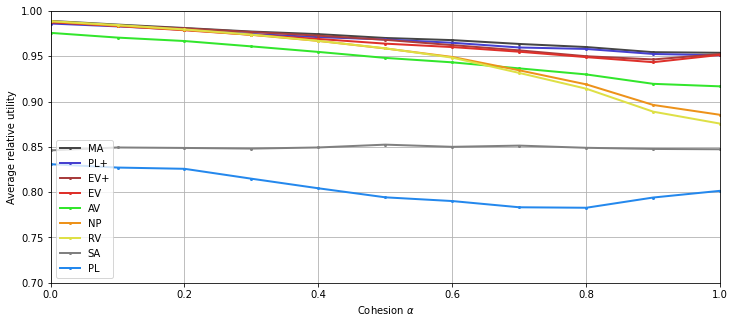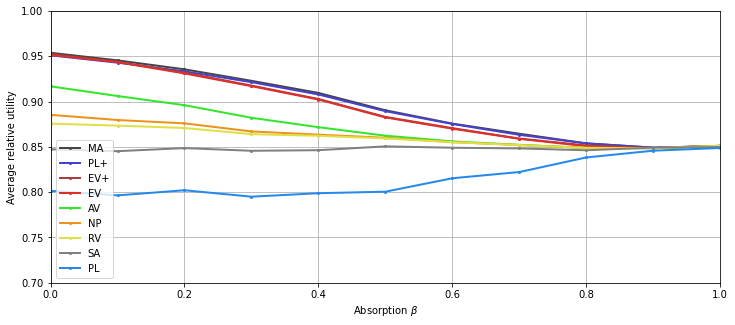Soft Partition of the Agents¶
This notebook investigates how the reference scenario evolves if: - The internal cohesion of the large group weakens. - The influence of the large group over the independent agents growths (absorption phenomenon).
[1]:
import numpy as np
import dill as pickle
import matplotlib.pyplot as plt
from tqdm import tqdm
import tikzplotlib
from multiprocess.pool import Pool
[2]:
import embedded_voting as ev # Our own module
Direct load of some useful variables and functions.
[3]:
from embedded_voting.experiments.aggregation import make_generator, make_aggs, f_max, f_renorm
from embedded_voting.experiments.aggregation import handles, colors, evaluate, default_order
[4]:
n_tries = 10000 # Number of simulations
n_training = 1000 # Number of training samples for trained rules
n_c = 20
Cohesion¶
Computation¶
We define the correlation matrix (the Euclidian row-normalization is performed by the generator).
[5]:
def mymatrix_homogeneity(alpha):
M = np.eye(24)
for i in range(20):
M[i] = [alpha**(np.abs(j-i)) for j in range(20)]+[0]*4
return M
[6]:
res = np.zeros((9, 11))
list_alpha = [0.1*i for i in range(11)]
with Pool() as p:
for i, alpha in enumerate(list_alpha[:-1]):
groups = [1]*24
features = mymatrix_homogeneity(alpha)
generator = make_generator(groups=groups, features=features)
training = generator(n_training)
testing = generator(n_tries*n_c).reshape(generator.n_voters, n_tries, n_c)
truth = generator.ground_truth_.reshape(n_tries, n_c)
list_agg = make_aggs(groups=groups, features=features)
res[:, i] = evaluate(list_agg=list_agg, truth=truth, testing=testing, training=training, pool=p)
100%|███████████████████████████████████████████████████████████████████████████| 10000/10000 [00:20<00:00, 495.47it/s]
100%|███████████████████████████████████████████████████████████████████████████| 10000/10000 [00:16<00:00, 615.94it/s]
100%|███████████████████████████████████████████████████████████████████████████| 10000/10000 [00:15<00:00, 632.79it/s]
100%|███████████████████████████████████████████████████████████████████████████| 10000/10000 [00:15<00:00, 631.09it/s]
100%|███████████████████████████████████████████████████████████████████████████| 10000/10000 [00:15<00:00, 636.35it/s]
100%|███████████████████████████████████████████████████████████████████████████| 10000/10000 [00:15<00:00, 659.55it/s]
100%|███████████████████████████████████████████████████████████████████████████| 10000/10000 [00:15<00:00, 640.37it/s]
100%|███████████████████████████████████████████████████████████████████████████| 10000/10000 [00:15<00:00, 641.47it/s]
100%|███████████████████████████████████████████████████████████████████████████| 10000/10000 [00:15<00:00, 665.18it/s]
100%|███████████████████████████████████████████████████████████████████████████| 10000/10000 [00:14<00:00, 700.92it/s]
[7]:
# No need to recompute base case
with open('base_case_results.pkl', 'rb') as f:
ref_res = pickle.load(f)[:-1]
res[:, -1] = ref_res
We save the results.
[8]:
with open('cohesion.pkl', 'wb') as f:
pickle.dump(res, f)
Display¶
[9]:
plt.figure(figsize=(12,5))
for i, agg in enumerate(list_agg):
plt.plot(list_alpha, res[i,:], 'o-', color=colors[agg.name], label=handles[agg.name],
linewidth=2, markersize=2)
plt.legend()
plt.xlabel("Cohesion $\\alpha$")
plt.ylabel("Average relative utility")
# plt.title("Alpha")
plt.ylim(0.7,1)
plt.xlim(0,1)
plt.grid()
tikzplotlib.save("cohesion.tex", axis_height ='6cm', axis_width ='8cm')
# save figure:
plt.savefig("cohesion.png")
plt.show()

Absorption¶
Computation¶
[10]:
def mymatrix_absorption(beta):
M = np.eye(5)
for i in range(4):
M[i+1,0] = beta
M[i+1,i+1] = 1-beta
return M
[11]:
res = np.zeros((9, 11))
res[:, 0] = ref_res
list_beta = [0.1*i for i in range(11)]
with Pool() as p:
for i, beta in enumerate(list_beta[1:]):
groups = [20]+[1]*4
features = mymatrix_absorption(beta)
generator = make_generator(groups=groups, features=features)
training = generator(n_training)
testing = generator(n_tries*n_c).reshape(generator.n_voters, n_tries, n_c)
truth = generator.ground_truth_.reshape(n_tries, n_c)
list_agg = make_aggs(groups=groups, features=features)
res[:, i+1] = evaluate(list_agg=list_agg, truth=truth, testing=testing, training=training, pool=p)
100%|███████████████████████████████████████████████████████████████████████████| 10000/10000 [00:17<00:00, 577.24it/s]
100%|███████████████████████████████████████████████████████████████████████████| 10000/10000 [00:14<00:00, 692.22it/s]
100%|███████████████████████████████████████████████████████████████████████████| 10000/10000 [00:17<00:00, 568.29it/s]
100%|███████████████████████████████████████████████████████████████████████████| 10000/10000 [00:14<00:00, 702.97it/s]
100%|███████████████████████████████████████████████████████████████████████████| 10000/10000 [00:14<00:00, 690.11it/s]
100%|███████████████████████████████████████████████████████████████████████████| 10000/10000 [00:14<00:00, 695.19it/s]
100%|███████████████████████████████████████████████████████████████████████████| 10000/10000 [00:14<00:00, 700.98it/s]
100%|███████████████████████████████████████████████████████████████████████████| 10000/10000 [00:18<00:00, 546.87it/s]
100%|███████████████████████████████████████████████████████████████████████████| 10000/10000 [00:14<00:00, 686.72it/s]
100%|███████████████████████████████████████████████████████████████████████████| 10000/10000 [00:14<00:00, 698.80it/s]
We save the results.
[12]:
with open('absorption.pkl', 'wb') as f:
pickle.dump(res, f)
Display¶
[13]:
plt.figure(figsize=(12,5))
for i, agg in enumerate(list_agg):
plt.plot(list_beta, res[i,:], 'o-', color=colors[agg.name], label=handles[agg.name],
linewidth=2, markersize=2)
plt.legend()
plt.xlabel("Absorption $\\beta$")
plt.ylabel("Average relative utility")
plt.ylim(0.7,1)
plt.xlim(0,1)
plt.grid()
tikzplotlib.save("absorption.tex", axis_height ='6cm', axis_width ='8cm')
# save figure:
plt.savefig("absorption.png")
plt.show()
